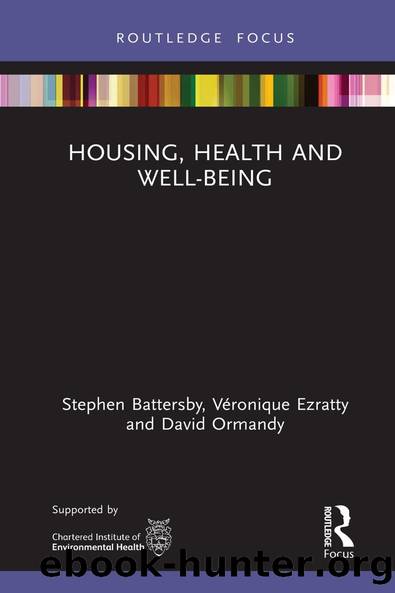Housing, Health and Well-Being by unknow

Author:unknow
Language: eng
Format: epub
ISBN: 9781138096981
Google: I7IayAEACAAJ
Publisher: Routledge, Taylor & Francis group
Published: 2019-10-15T03:34:34+00:00
Shock and burn injuries
Electricity â Contact with metal or other conducting material that is âliveâ (i.e., connected to a supply of electricity) can result in an electric shock. The shock effect ranges from mild tingling sensations to disruption of the normal regular contractions of the heart or respiratory muscles, causing death. The effect depends on several factors, the main one being the voltage across the body.
As human tissue acts as a resistance, the heat generated may result in burns, usually occurring at the point of contact with the source of electricity.
While the majority of injuries are not severe, death can be an outcome. Fatalities can be caused by a defect or deficiency in the electrical wiring and other installations, and such defects may also be the source of ignition for a fire.
The potential danger of electrocution means that safety precautions should be incorporated. The precautions are directed to isolation and/or insulation. Potentially âliveâ components are covered with non-conducting material, all exposed metal parts of the installation are âearthedâ (so that in the event of a deficiency any current will flow immediately to earth), and for installations at 230 volts AC or higher, a residual current device or residual current circuit breaker (RCD and RCCB) can provide additional safety and be incorporated into the consumer unit (the distribution boards immediately after the mains supply). RCDs and RCCBs are devices that detect some, but not all, deficiencies in the electrical system and rapidly switch off the supply.
Where there are insufficient and/or poorly located electric sockets there can be overloading of the circuit by use of extension cables or multi-socket adapters that can lead to fires (see below, p. 46), and trailing cables that provide a trip hazard.
As water is highly conductive, additional precautions are considered necessary in most countries for bathrooms, kitchens, and other areas where individuals could be in contact with both water and a source of electricity. This usually involves restrictions on electric socket outlets to 12 volt AC sockets, such as shaver sockets in bathrooms (although there are no restrictions in kitchens).
For tall and isolated buildings, a lightning protection system may be necessary where, depending on the geographical location, there is a risk of a lightning strike.
Hot surfaces, materials, and exposed flames â Contact with these sources can result in burns or scalds, and it is these sources that account for the great majority of non-fatal burn accidents. The severity of the burn or scald is dependent on its depth and the area covered. The depth of burn is dependent on the temperature of the hot object or liquid, the length of time of exposure, the time taken before corrective action is taken (such as the application of cold water). The length of time that hot material can be touched without damage to human tissue depends on the material, as well as the temperature.
Severe burns or scalds can result in permanent scarring. And, as well as obvious physical pain, many victims, and also parents of children involved, suffer acute psychological distress for many years.
Download
This site does not store any files on its server. We only index and link to content provided by other sites. Please contact the content providers to delete copyright contents if any and email us, we'll remove relevant links or contents immediately.
| Breast Cancer | Candida |
| Chronic Fatigue Syndrome & Fibromyalgia | Endometriosis |
| General | Lupus |
| Menopause | Menstruation |
| Postpartum Depression | Pregnancy & Childbirth |
| Sexual Health |
Name Book, The: Over 10,000 Names--Their Meanings, Origins, and Spiritual Significance by Astoria Dorothy(2496)
Tone Your Tummy Type by Denise Austin(2372)
The Women's Health Fitness Fix by Jen Ator(1928)
The Expectant Father by Armin A. Brott & Jennifer Ash(1898)
The Coregasm Workout by Debby Herbenick(1824)
The Ultimate Guide to Anal Sex for Women by Tristan Taormino(1758)
Expecting Better by Emily Oster(1712)
She-ology by Sherry A. Ross MD(1701)
The Hite Report on Shere Hite by Shere Hite(1666)
8 Steps to Reverse Your PCOS by Fiona McCulloch(1598)
Woman: An Intimate Geography by Natalie Angier(1586)
Birth by Tina Cassidy(1573)
Women & the Weight Loss Tamasha by Diwekar Rujuta(1528)
The Female Brain by M.D. Louann Brizendine(1518)
101 Get-Lean Workouts and Strategies by Muscle & Fitness(1509)
50 Ways to Soothe Yourself Without Food by Susan Albers(1403)
The Big Booty Blueprint: Your Guide To A Bigger Butt In Less Than 12 Weeks by Bella Rahbek & Brandon Carter(1369)
Unleash the Power of the Female Brain: Supercharging Yours for Better Health, Energy, Mood, Focus, and Sex by Daniel G. Amen M.D(1289)
The overachievers by Robbins Alexandra(1287)
